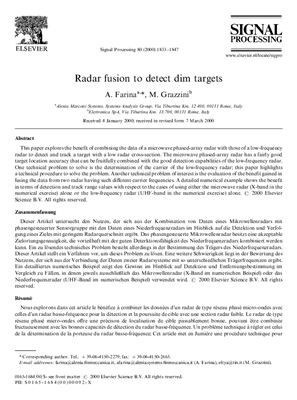Signal Processing 80 (2000) 1833}1847
Abstract
This paper explores the bene"t of combining the data of a microwave phased-array radar with those of a low-frequency radar to detect and track a target with a low radar cross-section. The microwave phased-array radar has a fairly good target location accuracy that can be fruitfully combined with the good detection capabilities of the low-frequency radar.
One technical problem to solve is the determination of the carrier of the low-frequency radar; this paper highlights a technical procedure to solve the problem. Another technical problem of interest is the evaluation of the bene"t gained in fusing the data from two radar having such di!erent carrier frequencies. A detailed numerical example shows the bene"t in terms of detection and track range values with respect to the cases of using either the microwave radar (X-band in the numerical exercise) alone or the low-frequency radar (UHF-band in the numerical exercise) alone.
Abstract
This paper explores the bene"t of combining the data of a microwave phased-array radar with those of a low-frequency radar to detect and track a target with a low radar cross-section. The microwave phased-array radar has a fairly good target location accuracy that can be fruitfully combined with the good detection capabilities of the low-frequency radar.
One technical problem to solve is the determination of the carrier of the low-frequency radar; this paper highlights a technical procedure to solve the problem. Another technical problem of interest is the evaluation of the bene"t gained in fusing the data from two radar having such di!erent carrier frequencies. A detailed numerical example shows the bene"t in terms of detection and track range values with respect to the cases of using either the microwave radar (X-band in the numerical exercise) alone or the low-frequency radar (UHF-band in the numerical exercise) alone.

